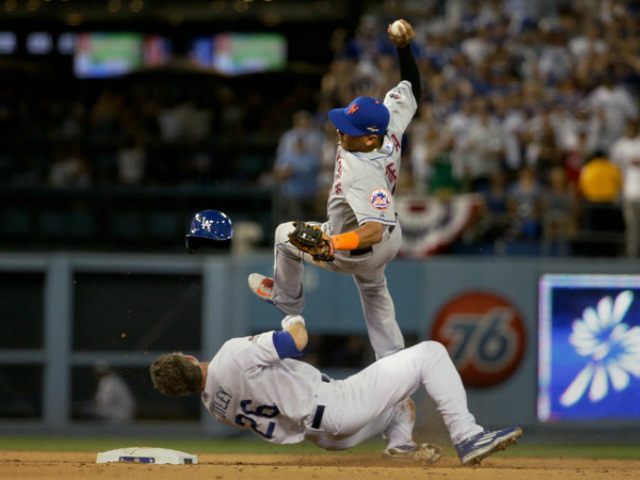Several new rules have been agreed upon by Major League Baseball and the Major League Baseball Players Association this week, one to ban the rolling block of infielders by base runners during a double play and two others aimed at making game play a bit faster.
The new slide rule is meant to put a stop to the sort of pseudo slides base runners have used to interfere with basemen as they attempt to make a double play. In the past runners have been given wider latitude to get to the base in anyway necessary but some runners have also used that latitude to interfere with and in some cases essentially tackle an infielder to the ground to prevent the opposing player from throwing to his fellow basemen.
The most blatant recent example of this sort of blocking was when the Los Angeles Dodgers’ Chase Utley delivered a leg fracture to New York Mets shortstop Ruben Tejada in the midst of an attempted double play in the 2015 playoffs.
It was a hit so blatant some even wondered if Utley would be open for arrest for assault by police. The incident also sent many commentators demanding a rule to make such a hit illegal in the MLB.
Certainly the league didn’t ignore Utley’s action until now. The Dodger was handed a two-game suspension immediately after his rolling block. But now the league has gone farther by officially outlawing rolling blocks such as the one Utley perpetrated last year.
The new rule would outlaw runners from initiating any intentional interference with basemen. Runners can still make contact with an infielder, but may not kick his leg above the knee, throw his arms, or make contact with the infielder’s upper body. Runners must also make a good faith effort to begin a slide into base.
An umpire can rule a slide either a “bona fide slide” or a violation calling both the runner and the batter out for a violation.
“Our goal in amending the slide rule was to enhance player safety, reduce incidents of injury and to do it in a way that respects and preserves the bona fide hustle plays that are integral to our game,” Tony Clark, executive director of the MLBPA, said on MLB.com. “I am optimistic that this new rule will accomplish those goals.”
Another rules change will limit the amount of time managers may visit the pitcher’s mound. The new limit is set at 30 seconds and is part of the pace-of-game initiative meant to make game play a bit faster.
The other pace-of-game rule concerns breaks. As described by MLB.com, “between-inning break times will now match the commercial time: 2 minutes, 5 seconds for local broadcasts and 2 minutes, 25 seconds for nationally televised games.”
By some estimates last year’s pace-of-game rules changes sped up game time up by some six minutes.
Follow Warner Todd Huston on Twitter @warnerthuston or email the author at igcolonel@hotmail.com

COMMENTS
Please let us know if you're having issues with commenting.